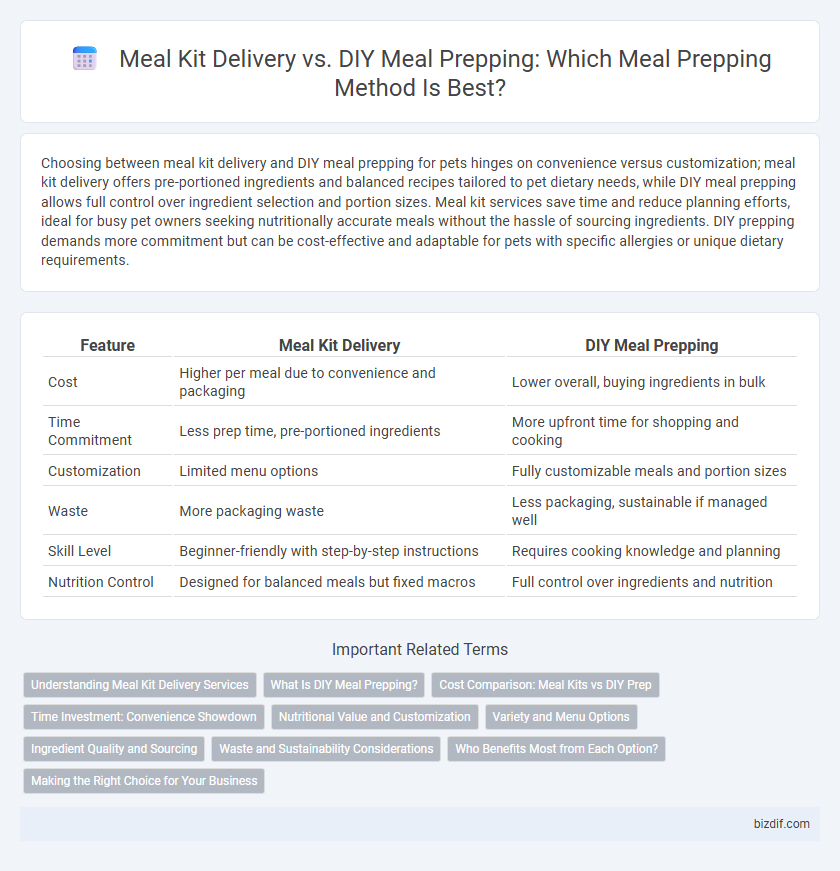Choosing between meal kit delivery and DIY meal prepping for pets hinges on convenience versus customization; meal kit delivery offers pre-portioned ingredients and balanced recipes tailored to pet dietary needs, while DIY meal prepping allows full control over ingredient selection and portion sizes. Meal kit services save time and reduce planning efforts, ideal for busy pet owners seeking nutritionally accurate meals without the hassle of sourcing ingredients. DIY prepping demands more commitment but can be cost-effective and adaptable for pets with specific allergies or unique dietary requirements.
Table of Comparison
| Feature | Meal Kit Delivery | DIY Meal Prepping |
|---|---|---|
| Cost | Higher per meal due to convenience and packaging | Lower overall, buying ingredients in bulk |
| Time Commitment | Less prep time, pre-portioned ingredients | More upfront time for shopping and cooking |
| Customization | Limited menu options | Fully customizable meals and portion sizes |
| Waste | More packaging waste | Less packaging, sustainable if managed well |
| Skill Level | Beginner-friendly with step-by-step instructions | Requires cooking knowledge and planning |
| Nutrition Control | Designed for balanced meals but fixed macros | Full control over ingredients and nutrition |
Understanding Meal Kit Delivery Services
Meal kit delivery services provide pre-portioned ingredients and step-by-step recipes, making meal preparation more convenient and time-efficient compared to DIY meal prepping. These services offer diverse menu options catering to dietary preferences such as keto, vegan, and gluten-free, simplifying ingredient sourcing and reducing food waste. Subscription models often include flexible delivery schedules and customizable meal plans, enhancing user experience and meal variety.
What Is DIY Meal Prepping?
DIY meal prepping involves planning, purchasing, and preparing meals independently to save time and ensure portion control throughout the week. It requires selecting recipes, buying ingredients in bulk, and using storage containers to organize meals in advance, often leading to cost savings and customized nutrition. This method contrasts with meal kit delivery services by offering greater flexibility and control over ingredient quality and meal variety.
Cost Comparison: Meal Kits vs DIY Prep
Meal kit delivery services typically cost between $8 to $12 per serving, whereas DIY meal prepping can reduce costs to approximately $3 to $5 per serving by buying ingredients in bulk and leveraging sales. Meal kits offer convenience and time savings but often include packaging fees and higher markup prices compared to buying raw ingredients for DIY meals. Budget-conscious consumers can save up to 50% by opting for DIY meal prepping while controlling portion sizes and ingredient quality.
Time Investment: Convenience Showdown
Meal kit delivery services significantly reduce time investment by providing pre-portioned ingredients and easy-to-follow recipes, streamlining the cooking process for busy individuals. DIY meal prepping demands more upfront time for grocery shopping, ingredient preparation, and portioning but offers greater flexibility and customization. Choosing between the two depends on the balance of convenience versus control over ingredients and meal variety.
Nutritional Value and Customization
Meal kit delivery services offer convenience and pre-portioned ingredients with balanced nutritional profiles curated by dietitians, ensuring consistent macro and micronutrient intake. DIY meal prepping allows greater customization to individual dietary preferences, restrictions, and nutrient goals by selecting ingredients and adjusting portions, optimizing for specific health outcomes like low sodium or high protein. Nutritional value in DIY prepping can vary widely based on ingredient quality and cooking methods, while meal kits provide standardized nutrition but may include preservatives or less flexibility.
Variety and Menu Options
Meal kit delivery services offer extensive variety with rotating menus featuring diverse cuisines and specialty diets, making it easy to explore new flavors without extensive planning. DIY meal prepping provides full control over ingredient selection and customization but often requires more effort to maintain variety and avoid repetitive meals. Choosing between the two depends on preferences for convenience, flexibility, and culinary experimentation.
Ingredient Quality and Sourcing
Meal kit delivery services often source high-quality, fresh, and pre-portioned ingredients directly from trusted suppliers, ensuring consistency and reducing food waste for consumers. DIY meal prepping allows for full control over ingredient selection, enabling shoppers to prioritize organic, local, or specialty items based on personal preferences and budget. Both approaches can offer nutrient-rich meals, but ingredient quality and sourcing transparency tend to vary depending on the chosen method and supplier.
Waste and Sustainability Considerations
Meal Kit Delivery services often generate significant packaging waste due to individually wrapped ingredients and insulated containers, raising sustainability concerns despite portion control benefits. DIY Meal Prepping allows for better waste management by utilizing bulk ingredients and reusable containers, reducing single-use plastics and food waste more effectively. Choosing sustainable sourcing and composting food scraps further optimizes environmental impact in both approaches.
Who Benefits Most from Each Option?
Meal kit delivery services benefit busy professionals and individuals seeking convenience and time-saving meal solutions with pre-portioned ingredients and easy-to-follow recipes. DIY meal prepping suits health enthusiasts and budget-conscious cooks who prefer full control over ingredient selection, portion sizes, and meal customization. Families aiming to reduce food waste and enhance nutrition also gain value from personalized meal prepping strategies.
Making the Right Choice for Your Business
Choosing between meal kit delivery and DIY meal prepping depends on your business model and target market preferences. Meal kit delivery offers convenience and reduced prep time, appealing to customers seeking hassle-free cooking experiences, while DIY meal prepping emphasizes customization and cost control, attracting budget-conscious or health-focused clients. Evaluating operational costs, scalability, and consumer demand will guide you in making the right choice for sustainable growth and customer satisfaction.
Meal Kit Delivery vs DIY Meal Prepping Infographic

 bizdif.com
bizdif.com